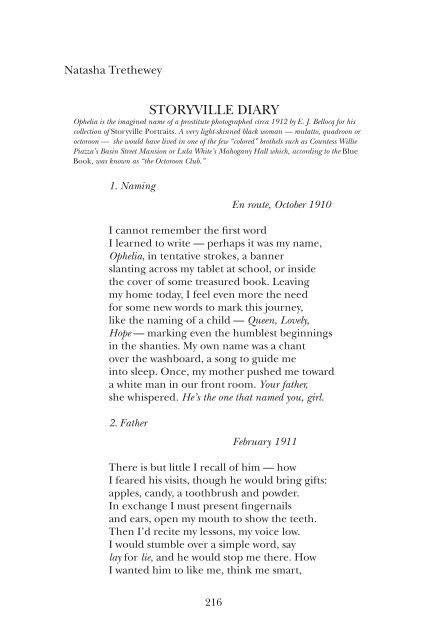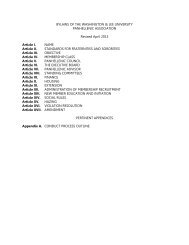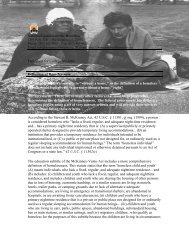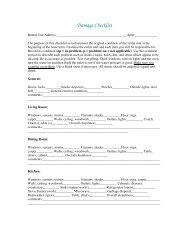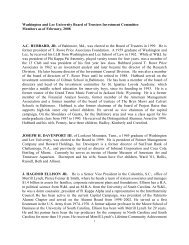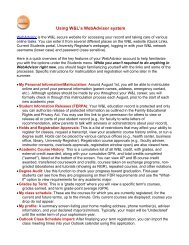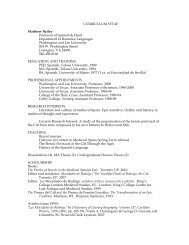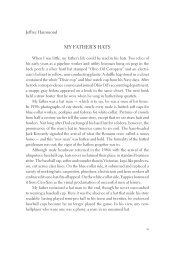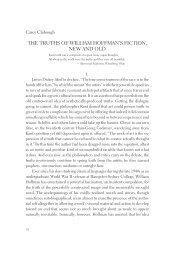STORYVILLE DIARY
STORYVILLE DIARY
STORYVILLE DIARY
You also want an ePaper? Increase the reach of your titles
YUMPU automatically turns print PDFs into web optimized ePapers that Google loves.
SHENANDOAH<br />
Natasha Trethewey<br />
STORY VILLE <strong>DIARY</strong><br />
Ophelia is the imagined name of a prostitute photographed circa 1912 by E. J. Bellocq for his<br />
collection of Storyville Portraits. A very light-skinned black woman — mulatto, quadroon or<br />
octoroon — she would have lived in one of the few “colored” brothels such as Countess Willie<br />
Piazza’s Basin Street Mansion or Lula White’s Mahogany Hall which, according to the Blue<br />
Book, was known as “the Octoroon Club.”<br />
1. Naming<br />
216<br />
En route, October 1910<br />
I cannot remember the first word<br />
I learned to write — perhaps it was my name,<br />
Ophelia, in tentative strokes, a banner<br />
slanting across my tablet at school, or inside<br />
the cover of some treasured book. Leaving<br />
my home today, I feel even more the need<br />
for some new words to mark this journey,<br />
like the naming of a child — Queen, Lovely,<br />
Hope — marking even the humblest beginnings<br />
in the shanties. My own name was a chant<br />
over the washboard, a song to guide me<br />
into sleep. Once, my mother pushed me toward<br />
a white man in our front room. Your father,<br />
she whispered. He’s the one that named you, girl.<br />
2. Father<br />
February 1911<br />
There is but little I recall of him — how<br />
I feared his visits, though he would bring gifts:<br />
apples, candy, a toothbrush and powder.<br />
In exchange I must present fingernails<br />
and ears, open my mouth to show the teeth.<br />
Then I’d recite my lessons, my voice low.<br />
I would stumble over a simple word, say<br />
lay for lie, and he would stop me there. How<br />
I wanted him to like me, think me smart,
a delicate colored girl — not the wild<br />
pickaninny roaming the fields, barefoot.<br />
I search now for his face among the men<br />
I pass in the streets, fear the day a man<br />
enters my room both customer and father.<br />
3. Bellocq<br />
217<br />
April 1911<br />
There comes a quiet man now to my room —<br />
Papá Bellocq, his camera on his back.<br />
He wants nothing, he says, but to take me<br />
as I would arrange myself, fully clothed —<br />
a brooch at my throat, my white hat angled<br />
just so — or not, the smooth map of my flesh<br />
awash in afternoon light. In my room<br />
everything’s a prop for his composition —<br />
brass spittoon in the corner, the silver<br />
mirror, brush and comb of my toilette.<br />
I try to pose as I think he would like — shy<br />
at first, then bolder. I’m not so foolish<br />
that I don’t know this photograph we make<br />
will bear the stamp of his name, not mine.<br />
4. Blue Book<br />
NATASHA TRETHEwEY<br />
June 1911<br />
I wear my best gown for the picture —<br />
white silk with seed pearls and ostrich feathers —<br />
my hair in a loose chignon. Behind me,<br />
Bellocq’s black scrim just covers the laundry —<br />
tea towels, bleached and frayed, drying on the line.<br />
I look away from his lens to appear<br />
demure, to attract those guests not wanting<br />
the lewd sighs of Emma Johnson’s circus.
SHENANDOAH<br />
Countess writes my description for the book —<br />
“Violet,” a fair-skinned beauty, recites<br />
poetry and soliloquies; nightly<br />
she performs her tableau vivant, becomes<br />
a living statue, an object of art —<br />
and I fade again into someone I’m not.<br />
5. Portrait #1<br />
218<br />
July 1911<br />
Here, I am to look casual, even<br />
frowsy, though still queen of my boudoir.<br />
A moment caught as if by accident —<br />
pictures crooked on the walls, newspaper<br />
sprawled on the dresser, a bit of pale silk<br />
spilling from a drawer, and my slip pulled<br />
below my white shoulders, décolleté,<br />
black stockings, legs crossed easy as a man’s.<br />
All of it contrived except for the way<br />
the flowered walls dominate the backdrop<br />
and close in on me as I pose, my hand<br />
at rest on my knee, a single finger<br />
raised, arching toward the camera — a gesture<br />
before speech, before the first word comes out.<br />
6. Portrait #2<br />
August 1911<br />
I pose nude for this photograph, awkward,<br />
one arm folded behind my back, the other<br />
limp at my side. Seated, I raise my chin,<br />
my back so straight I imagine the bones<br />
separating in my spine, my neck lengthening<br />
like evening shadow. when I see this plate<br />
I try to recall what I was thinking —<br />
how not to be exposed, though naked, how
to wear skin like a garment, seamless.<br />
Bellocq thinks I’m right for the camera, keeps<br />
coming into my room. These plates are fragile,<br />
he says, showing me how easy it is<br />
to shatter this image of myself, how<br />
a quick scratch carves a scar across my chest.<br />
7. Photography<br />
219<br />
October 1911<br />
Bellocq talks to me about light, shows me<br />
how to use shadow, how to fill the frame<br />
with objects — their intricate positions.<br />
I thrill to the magic of it — silver<br />
crystals like constellations of stars<br />
arranging on film. In the negative<br />
the whole world reverses, my black dress turned<br />
white, my skin blacked to pitch. Inside out,<br />
I said, thinking of what I’ve tried to hide.<br />
I follow him now, watch him take pictures.<br />
I look at what he can see through his lens<br />
and what he cannot — silverfish behind<br />
the walls, the yellow tint of a faded bruise —<br />
other things here, what the camera misses.<br />
8. Disclosure<br />
NATASHA TRETHEwEY<br />
January 1912<br />
when Bellocq doesn’t like a photograph<br />
he scratches across the plate. But I know<br />
other ways to obscure a face — paint it<br />
with rouge and powder, shades lighter than skin,<br />
don a black velvet mask. I’ve learned to keep<br />
my face behind the camera, my lens aimed<br />
at a dream of my own making. what power
SHENANDOAH<br />
I find in transforming what is real — a room<br />
flushed with light, calculated disarray.<br />
Today I tried to capture a redbird<br />
perched on the tall hedge. As my shutter fell,<br />
he lifted in flight, a vivid blur above<br />
the clutter just beyond the hedge — garbage,<br />
rats licking the insides of broken eggs.<br />
9. Spectrum<br />
220<br />
February 1912<br />
No sun, and the city’s a dull palette<br />
of gray — weathered ships docked at the quay, rats<br />
dozing in the hull, drizzle slicking dark stones<br />
of the streets. Mornings such as these, I walk<br />
among the weary, their eyes sunken<br />
as if each body, diseased and dying,<br />
would pull itself inside, back to the shining<br />
center. In the cemetery, all the rest,<br />
their resolute bones stacked against the pull<br />
of the Gulf. Here, another world teems — flies<br />
buzzing the meat-stand, cockroaches crisscrossing<br />
the banquette, the curve and flex of larvae<br />
in the cisterns, and mosquitoes skimming<br />
flat water like skaters on a frozen pond.<br />
10. (Self) Portrait<br />
March 1912


